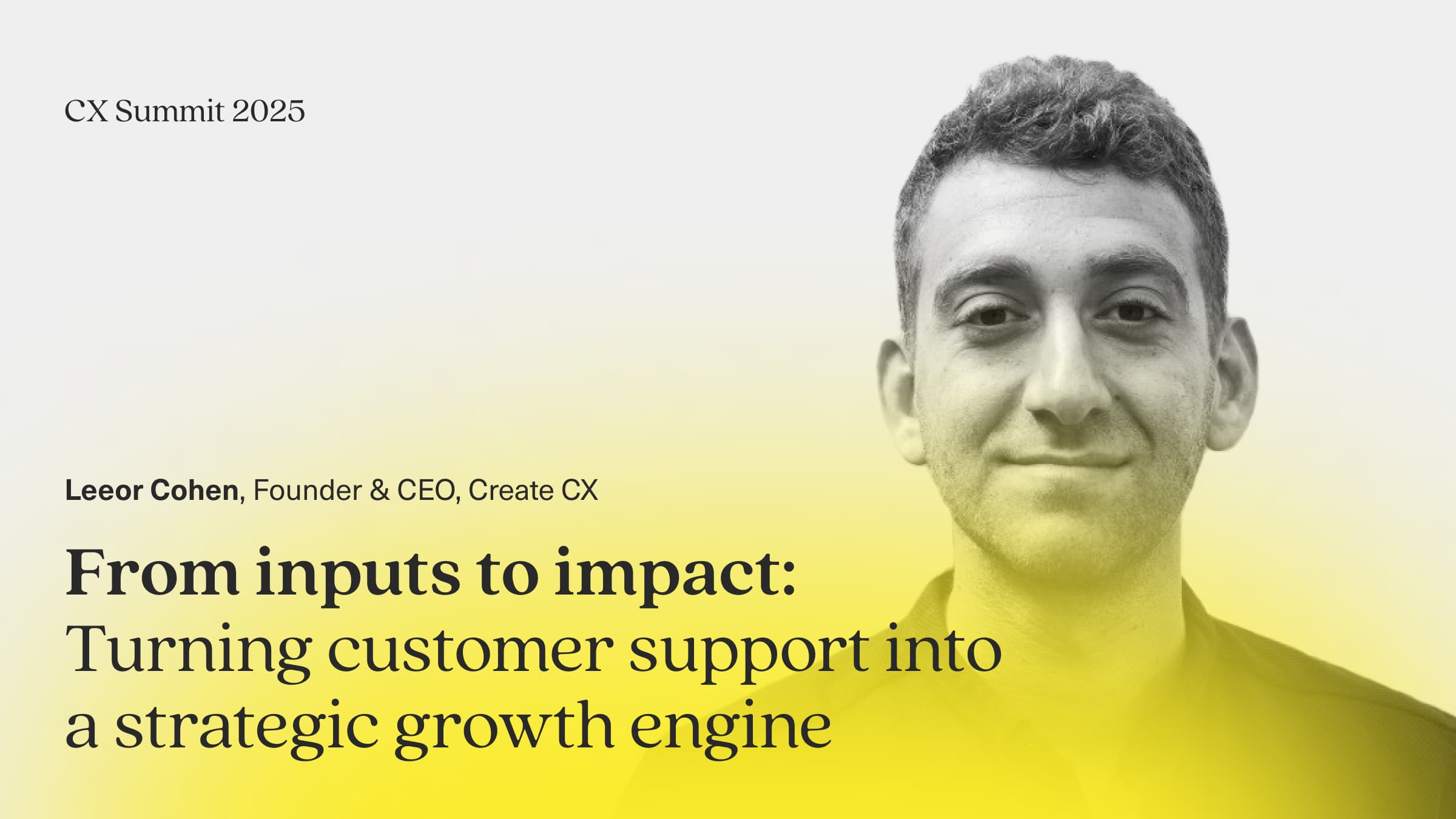Leeor Cohen, founder of CreateCX, brings deep expertise in CX, ecommerce, and operations—from scaling Slice’s support team from 5 to 500, to leading all things tech, ops, and customer experience at Coterie Baby. In this interview, he shares how CreateCX acts as a fractional VP of CX, helping brands—from scrappy startups to scaled enterprises—build smarter, more strategic, and scalable support operations from the ground up.
This interview has been edited for clarity.
Gabe Larsen: To start, you have talked before about inbound tickets being inputs, not just problems to solve, which I found really interesting. Can you expand on how brands can transform those inputs into real business impact?
Leeor Cohen: Absolutely. Inputs to outputs is a mantra we use at CreateCX. Every business department has inputs that drive outputs. In customer experience, every customer question—whether it is before purchase, during, after, or during returns—is an input.
Too many businesses focus only on solving problems without realizing those interactions are valuable data points. They are feedback not just for CX, but for product, digital, operations, and marketing teams. Each ticket should be categorized and fed into other departments, giving CX leaders real ammunition to show how frontline interactions are shaping the business and creating tangible outputs elsewhere.
Gabe: I like that framework. Simple to say, harder to execute, I am sure.
Leeor: Definitely. Every business likes to say, "Our situation is unique," and while that is true, there are fundamental truths across ecommerce and retail. Solving the simplest problems at the highest level of complexity is the real game. If you are learning from every customer interaction, that is how you truly improve your department and influence the broader business.
Gabe: You have mentioned before that a lot of companies still treat CX as a cost center. How do you coach leaders through the mindset shift to make CX more of a growth driver?
Leeor: We see it all the time. It starts by tying CX directly into the financial model. We ask for the company’s projections and translate what those mean for CX ticket volume.
Major brand moments—product launches, big marketing pushes—create CX volume. We help leaders forecast that and prepare teams with the right size, coverage, and automation strategies. It is about routing properly, prioritizing the right tickets, and using AI and automation where it makes sense to handle 99% certainty inquiries.
If you get your people, processes, and technology aligned, you can shift CX from being purely a cost center to a strategic driver of revenue, loyalty, and customer lifetime value.
Gabe: What does a ticket mean to your organization? That idea really resonates with me.
Leeor: Exactly. It is about answering the right questions, not just having macros and SOPs for the sake of it. Are you actually solving the customer’s issue?
Every piece—your agents, your tech, your processes—should work seamlessly together. CX leaders who invest in thoughtful triage and workflows drive real business impact. Done right, CX creates advocates, drives repeat purchases, and reduces churn.
Gabe: You have worked with a lot of brands. What are some of the biggest blind spots you see when companies try to scale their CX?
Leeor: The biggest blind spot is in documentation and systematic thinking. Businesses often lose institutional knowledge through turnover or fast scaling. New agents do not know the "why" behind processes—they are just doing tasks.
Another huge issue is how they manage their help desks. We run audits and often find teams using "open inboxes" where everything is just mixed together. There is no prioritization.
Smart brands use data from Shopify, order details, and customer profiles to route tickets properly. Not all tickets need the same SLA. VIP customers or urgent order changes need faster handling than simple inquiries. Without this structure, teams just cherry-pick tickets, and CX becomes reactive rather than strategic.
Gabe: Sounds like most people treat their help desk like I treat my inbox—chaotic!
Leeor: Exactly. Snoozing and cherry-picking tickets are signs of a broken system. Good CX requires structured triage and a clear view into prioritization. It is all about creating clarity for agents so they can do their best work.
Gabe: You have a strong perspective on the role of technology too. How do you see tech fitting into this transformation?
Leeor: At CreateCX, our pillars are people, process, and technology. Now we are adding AI readiness. But ironically, AI readiness means doing those first three pillars extremely well.
Buying a new tool is just the beginning. Implementing workflows, keeping them updated, training agents on why processes matter—it is an ongoing effort. Technology and humans need to work together, not in silos.
We often see businesses launch a tool, build a couple of workflows, and then forget about it. CX is always evolving, so your tech stack and your agents' processes must evolve with it.
Gabe: That is a great callout. If you are not updating workflows regularly, you are going to fall behind.
Leeor: Exactly. We love shadowing agents and asking, "Why are you tagging this escalation manually?" Often the answer is, "That is how it has always been done." There is a better way—through automation, better training, and integrating business rules.
It is about not just building a technical solution, but educating the humans using it and maintaining feedback loops between the frontline team and leadership.
Gabe: I love it. People, process, technology—moving in unison. As we wrap, you work with a lot of scaling brands. What is a scrappy CX play you have seen work really well?
Leeor: One scrappy tip is to simplify your inbox views. We recently worked with a brand that had 50 inbox views for 12 agents. It was overwhelming. We cleaned it up to four or five essential inboxes based on priority: P0, P1, P2, and P3. When agents sign in, they know exactly what to work on and in what order.
Small changes like that create huge efficiencies. CX is not about rocket science. It is about stacking small wins, five to fifteen-minute improvements that add up to big gains over time. If you do that consistently, you will see your metrics improve, your agents happier, and your executives better informed. That is how you build a truly strategic CX organization.
Gabe: That is such a great takeaway. Optimizing, iterating, and making small improvements consistently. Love it. Thanks again for joining, Leeor. Tons of great insights.
Leeor: Thank you! Always a pleasure. We love being in the day-to-day with brands, helping them optimize and grow. CX should never be an afterthought. It should be one of your brand’s biggest strategic advantages.
Closing thoughts
Leeor Cohen reminds us that customer experience is not a back-office function—it is the front line of your brand’s growth strategy. From input-to-output frameworks to inbox simplification, the smartest CX leaders treat every interaction as a data point with business impact.
If your support team is just answering tickets, you are wasting your most valuable source of customer insight. CX is not a cost center. It is your competitive edge, if you build it right.
Looking for a comprehensive tool that can help you make big strides in your customer experience? Check out Kustomer. Our all-in-one customer service platform and CRM, powered by AI, allows brands to streamline costs and operations. Explore Kustomer today!




